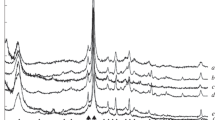Abstract
The synthesis of micro-/mesoporous beta zeolite by employing a solid precursor was described and its activity in the isopropylation of naphthalene was tested. The precursor was prepared by spray-drying of a homogenous mixture of silica sol, polyaluminum chloride solution and acidophilus milk, the presence of the latter induced formation of mesopores. The volume of mesopores of the synthesized beta zeolites ranged from 0.13 to 0.6 cm3/g and strongly depended on the concentration of tetraethylammonium hydroxide (TEAOH) in the reaction mixtures at the hydrothermal synthesis. Micro-/mesoporous beta zeolites exhibit positive effects of mesopores on the naphtalene conversion in its isopropylation by isopropyl alcohol, by improving the availability of active sites. With an increasing volume of mesopores, the conversion of naphthalene proportionally increases from 12 up to 27% for the volume of mesopores 0.6 cm3/g, while the selectivity to isopropylnaphthalene decreases from 92 to 55–66% for beta zeolites with 0.15–0.45 cm3 of mesopores/g, followed by selectivity increase up to mesopore volume 0.6 cm3/g reaching 81% at conversion 27%. A yield of isopropylnaphthalene is increasing in the whole range, particularly when the volume of mesopores exceeds 0.4 cm3/g. A zeolite with the highest volume of mesopores provides 1.8 times higher yield of isopropylnaphthalene then a microporous beta zeolite without mesopores. The increasing conversion of naphthalene is accompanied by a decrease in the selectivity to isopropylnaphthalene for zeolites with a low volume of mesopores, but an increasing selectivity to isopropylnaphthalene in the case of zeolites with a volume of mesopores above 0.4 cm3/g. This unusual effect can be explained by the mesoporosity of zeolites. Mesopores improve the availability of active centers, so they react faster, but the by-products are also formed faster and later undesired reactions run more easily as active centers are gradually blocked by by-products. Zeolites with the largest pores provide not only better availability of active centers, but the reaction products can also leave the zeolitic phase more easily and undesirable reactions have less chance to occur. This method of micro/mesoporous beta zeolite synthesis is advantageous for its low cost.








Similar content being viewed by others
References
Corma A, Grande MS, Gonzales Alfaro V, Orchiles AV (1996) J Catal 159:375
Cassiers K, Linssen T, Mathieu M, Benjelloun M, Schrijnemakers K, van Der Voort P, Cool P, Vansant EF (2002) Chem Mater 14:2317–2324
Martens JA, Jammaer J, Bajpe S, Aerts A, Lorgouilloux Y (2011) Microporous Mesoporous Mater 140:2–8
Cejka J, van Bekkum H, Corma A, Schüth F (2007) Stud Surf Sci Catal 168:302
Moller K, Bein T (2013) Chem Soc Rev 42:3689–3707
Liu Y, Pinnavaia TJ (2002) J Mater Chem 12:3179
Liu Y, Zhang W, Pinnavaia TJ (2001) Angew. Chem Int Ed 7:40
Liu Y, Zhang W, Pinnavaia TJ (2000) Am Chem Soc 122:8791
Xiao FS (2005) Top Catal 35:9
Prokesova P, Mintova S, Čejka J, Bein T (2003) Mater Sci Eng C 23:1001–1005
Tosheva L, Valtchev VP (2005) Chem Mater 17(10):2494–2513
Choi M, Na K, Kim J, Sakamoto Y, Terasaki O, Ryoo R (2009) Nature 461:246
Corma A (2009) Nature 461:182
Petushkov A, Yoon S, Larsen SC (2011) Microporous Mesoporous Mater 137:92–100
Xue T, Chen L, Wang M, He MY (2012) Microporous Mesoporous Mater 156:97–105
Larlus O, Mintova S, Wilson ST, Willis RR, Abrevaya H, Bein T (2011) Microporous Mesoporous Mater 142:17–25
Botella P, Corma A, Lopez-Nieto JM, Valencia S, Jacquot R (2000) J Catal 195:161
Cejka J, Mintova s (2007) Catal Rev Sci Eng 49(4):457–509
Boisen A, Schmidt I, Carlsson A, Dahl S, Brorson M, Jacobsen CJH (2003) Chem Commun 8:958
Janssen AH, Schmidt I, Jacobsen CJH, Koster AJ, de Jong KP (2003) Microporous Mesoporous Mater 65:59
Martínez A, Peris E, Derewinski M, Burkat-Dulak A (2011) Catal Today 169(1):75–84
Tao Y, Kanoh H, Hanzawa Y, Kaneko K (2004) Coll Surf A 241(1–3):75–80
Chen G, Juany L, Wang L, Zhang J (2010) Microporous Mesoporous Mater 134:189–194
Cho HS, Ryoo R (2012) Microporous Mesoporous Mater 151:107–112
Kustova M, Egeblad K, Zhu K, Christensen CH (2007) Chem Mater 19:2915–2917
Christensen CH, Zhu K, Kustova M, Egeblad K (2008) US 20080014140 A1
Wang X, Li G, Wang W, Jin C, Chen Y (2011) Microporous Mesoporous Mater 142:494–502
Sazama P, Wichterlova B, Dedecek J, Tvaruzkova Z, Musilova Z, Palubo L, Sklenak S, Gonsiorova O (2011) Microporous Mesoporous Mater 143:87–96
Ogura M, Shinomiya SY, Tateno J, Nara Y, Kikuchi E, Matsukata H (2000) Chem Lett 8:882–883
Groen JC, Pérez-Ramírez J, Peffer LAA (2002) Chem Lett 31(1):94
Su L, Liu L, Zhuang J, Wang H, Li Y, Shen W, Xu Y, Bao X (2003) Catal Lett 91:155–167
Yoo WC, Zhang X, Tspatsis M, Stein A (2012) Microporous Mesoporous Mater 149:147–157
Caicedo-Realpe R, Pérez-Ramírez J (2010) Microporous Mesoporous Mater 128:91–100
Yihui W, Tian F, Liu J, Song D, Jia C, Chen Y (2012) Microporous Mesoporous Mater 162:168–174
Petushkov A, Merilis G, Larsen SC (2011) Microporous Mesoporous Mater 143:97–103
Subhash SC, Venkatesan C, Sakthivel A, Komura K, Kim TH, Cho SJ, Huang SJ, Wu PH, Liu SB, Sasaki Y, Kobayashi M, Sugi Y (2010) Microporous Mesoporous Mater 133:82–90
Ooi YS, Zakaria R, Mohamed AR, Bhatia S (2004) Appl Catal A 274:15–23
Hould ND, Foster A, Lobo RF (2011) Microporous Mesoporous Mater 142:104–115
Chichester CO (1986) Advances in Food Research. Academic Press, Boston
Acknowledgements
This article is a result of the project “Development of the UniCRE Centre”, project Code LO1606, belonging to National Programme for Sustainability I of the Ministry of Education, Youth and Sports of the Czech Republic.
Author information
Authors and Affiliations
Corresponding author
Rights and permissions
About this article
Cite this article
Tokarova, V., Stavova, G., Novakova, J. et al. Synthesis of beta zeolite with mesopores from a milk containing precursor and its performance in naphthalene isopropylation. Reac Kinet Mech Cat 122, 343–356 (2017). https://doi.org/10.1007/s11144-017-1227-6
Received:
Accepted:
Published:
Issue Date:
DOI: https://doi.org/10.1007/s11144-017-1227-6




